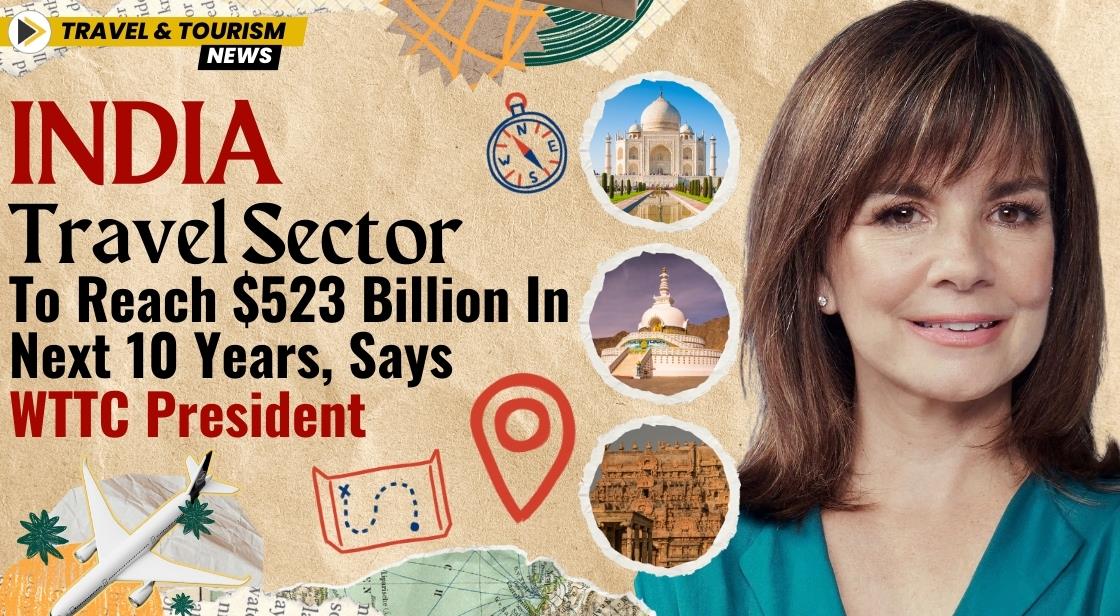India's Tourism Sector to Reach $523 Billion in Next 10 Years, Says WTTC President

News Synopsis
The World Travel and Tourism Council (WTTC) President and CEO, Julia Simpson, has projected that India’s tourism industry will experience significant growth in the next decade.
Simpson shared with a new agency that by 2034, the sector is expected to reach a massive value of $523 billion, marking a huge leap from its current valuation of $256 billion.
This growth will be accompanied by a notable increase in job opportunities, with an estimated 18 million new jobs expected to be created, boosting the employment rate in the sector from 45 million to 63 million. The tourism sector currently contributes approximately 7% to India's GDP.
India's Growing Appeal as a Tourist Destination
Simpson praised India’s historical and cultural appeal, emphasizing the country’s attractiveness as a global tourism hub. She acknowledged India’s hospitality and rich heritage, which continue to draw international tourists.
The diverse range of experiences available—from ancient monuments and spiritual sites to contemporary cultural attractions—makes India an essential destination for tourists worldwide.
Environmental Impact and Sustainability in Tourism
While lauding the tourism sector's growth, World Travel and Tourism Council (WTTC) President and CEO, Julia Simpson also addressed its environmental implications. Tourism is responsible for around 5% of India's greenhouse gas emissions, roughly translating to 250 billion kilograms of CO2 annually.
However, she pointed out that emissions have not increased in parallel with the sector's expansion, suggesting that there has been a degree of improvement in the industry’s efficiency in managing environmental impacts.
Green Initiatives: A Call for Sustainable Aviation Fuel
Simpson stressed the importance of adopting sustainable aviation fuel to reduce the carbon footprint of the tourism industry. Aviation plays a crucial role in global tourism, and she urged the Indian government to support the development and use of sustainable fuel solutions to lessen environmental damage.
"We can't really do tourism without aviation," Simpson remarked, highlighting the importance of these initiatives for the long-term sustainability of the industry. The World Travel and Tourism Council (WTTC) has been actively engaging with Indian authorities on these matters at major events like the World Travel Market to encourage eco-friendly practices in tourism.
Tourism and Job Creation in India: Diverse Opportunities for Growth
The tourism sector in India provides a wide range of employment opportunities across various levels. From high-end technical roles like engineers and AI experts to entry-level positions, the sector offers pathways for workers to transition from informal to formal economies. This diversity of jobs is a critical aspect of the sector’s potential to create long-term, stable employment in India.
Protecting Coastal Areas from Climate Change
Simpson highlighted the vulnerability of India’s coastal areas to the effects of climate change, including rising sea levels and extreme weather events. She emphasized the need for India to invest in protecting its coastline, citing Miami’s successful investment in infrastructure as an example of proactive steps that could be taken in India.
By safeguarding coastal regions, India could maintain its appeal as a top tourist destination while addressing environmental challenges.
Praise for India’s Leadership in Clean Energy
Simpson also praised Prime Minister Narendra Modi's commitment to clean energy, particularly his efforts to reduce air pollution through significant investments in solar and renewable energy.
She believes that under Modi’s leadership, India is on track to become one of the most advanced developing economies in the world. This progress not only positions India as a global economic leader but also enhances its attractiveness as a destination for international tourists.
Conclusion
Julia Simpson's optimistic predictions about the future of India’s tourism sector are grounded in the country’s robust economic growth and its ability to adapt to global trends.
With strong projections of job creation and increased revenue, along with a growing commitment to sustainability, India's tourism industry is poised to become a driving force in the global economy over the next decade.
The focus on green initiatives and job creation underscores the country’s dedication to balancing growth with environmental responsibility.
You May Like









